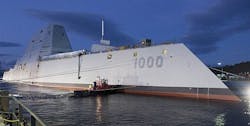Navy consideration of scrapping third ship of Zumwalt-class destroyer doesn't come as a surprise
The issue revolves around the Navy's Zumwalt-class destroyer, a 600-foot 14,800-ton maritime behemoth designed around the Advanced Gun System (AGS), a 155-millimeter cannon designed to hurl special shells as far as 83 nautical miles at a rate of 10 rounds per minute.
Navy leaders went forward with the Zumwalt destroyer program on the assumption that they would build 32 of these formidable shore-bombardment warships. Since then the number of planned Zumwalt destroyers dwindled to seven, and now to three.
The third ship of the class, the USS Lyndon B. Johnson, is at the eye of the storm. Navy leaders are considering scrapping the third Zumwalt land-attack destroyer, even though the vessel is already under construction, in efforts to cut the rising costs of the program.
Related: Navy's newest destroyers evolve to fill traditional battleship roles
The estimated procurement cost for all three vessels has increased by 37 percent since 2009 to $12.3 billion, according to a Bloomberg Business story by longtime defense reporter Anthony Capaccio, entitled General Dynamics Destroyer Reviewed by U.S. for Cancellation.
If you ask me, the death of the Zumwalt-class destroyer program has been a long time in coming. The big ship dedicated to shore bombardment has a questionable role in this era of cruise missiles, smart munitions, and modern jet fighter-bombers. Even if the ship were to fill an obvious need, how much punch would two or three ships offer?
Let's face it: cutting the size of an entire class of ships to two or three reduces the vessel to irrelevance. It does have a modern "stealthy" design to reduce its radar signature, but the thing is 12 stories tall and about the same mass as a Virginia-class battleship from generations ago. How stealthy can it be?
Experts argue that the Zumwalt-class destroyer packs an offensive punch found nowhere else in the Navy's fleet, except for the fighter-bomber aircraft aboard the aircraft carriers. That's a good point, and whittling down the Zumwalt program to essentially nothing, that's a capability the Navy will have to do without.
Losing the third ship of the Zumwalt class will save money and barely would be noticed by naval planners. No doubt its offensive capabilities would have been useful had the ship been built in substantial numbers, but not in just a handful.
All this is not to say that the Zumwalt destroyer program has been for nothing. The ship has value as a technology development laboratory -- albeit an expensive one.
The ship is designed with revolutionary power generation. It uses electricity generated by gas turbines to power all of its systems, including weapons. The Zumwalt's power system design potentially could be applied to new ship classes, or perhaps even as backfits to existing ship designs.
The Zumwalt design also offers a broad range of enabling technologies in systems automation to reduce the ship's complement of officers and enlisted personnel to operate the vessel efficiently. The Zumwalt requires only 140 officers and enlisted, while the Navy's much smaller Arleigh Burke-class destroyers destroyer requires 323.
Still, as a design for a ship that can stand on its own in the 21st century, I think the Zumwalt falls short. Despite its shore-bombardment capabilities, the ship isn't designed for anti-submarine warfare and ballistic missile defense, as some of the Navy's Burke-class destroyers are.
As Pentagon budget cutters look for ways to save money, the Zumwalt as a target was an obvious choice.


